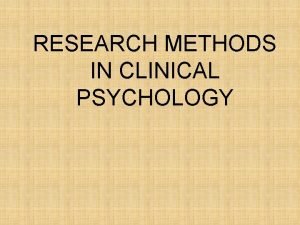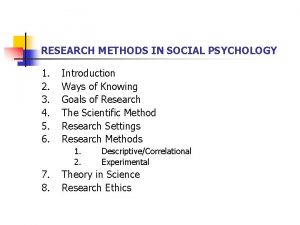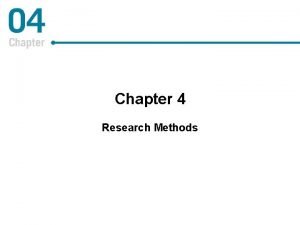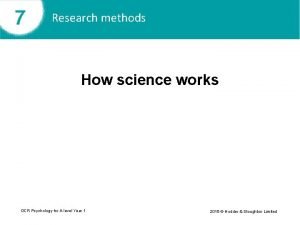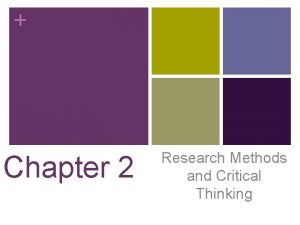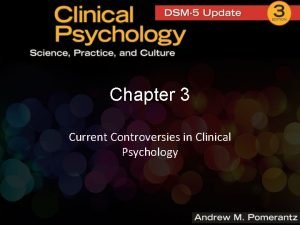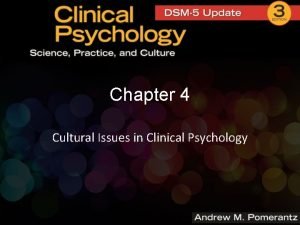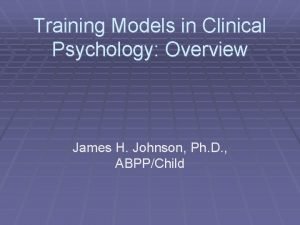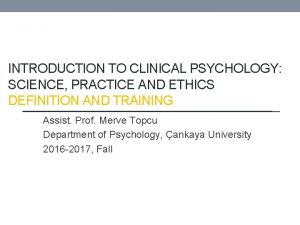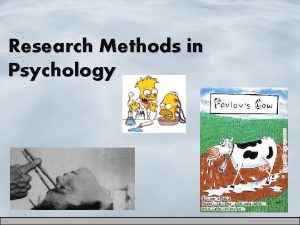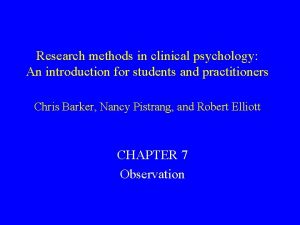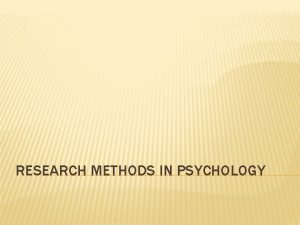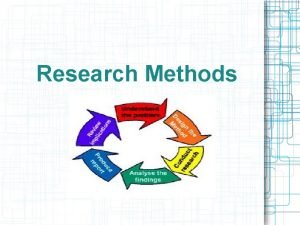RESEARCH METHODS IN CLINICAL PSYCHOLOGY INTRODUCTION TO RESEARCH




















- Slides: 20

RESEARCH METHODS IN CLINICAL PSYCHOLOGY

• INTRODUCTION TO RESEARCH In a reality, clinical psychology is a science as well as applied, therefore the research in clinical psychology is very necessary • The purpose of research is to prove the truth of a theory in practice • Research can inform our theories in a type of feedbackloop system, which is the research can help us extend and modify our theories as well as establish their parsimony and utility. • There is intimate relationship between theory and research. Theory stimulates and guides the research we do, but theories are also modified by the outcomes of researches.

Introduction To Research. . • For example, theory of the development Erikson, Oedipus complex Freud, the success of a treatment, the truth and the projection of personality tests in detecting the disorder symptoms. • The ultimate reason for research is the enhancement of our ability to predict and understand the behavior, feelings, and thoughts of the people served by clinical psycholgists and NOT for Generalized. • The final analysis, only better research will enable us to intervene wisely and effectively on their behave.

METHODS • There are many methods of research, each with its own advantages & limitations. • Therefore, no methods by itself will answer every question definitively. • But together, a variety of methods can significantly extend our ability to understand predict.

RESEARCH METHODS IN CLINICAL PSYCHOLOGY • • Observation Case study Epidemiological Research Correlational Methods Cross-Sectional Versus Longitudinal Approaches The experimental methods Single-case Design Mixed Designs

Observation • The most basic and pervasive of all research methods. • Several types of observations : 1. Unsystematic observation : observations made by accident / coincidence (casual observation). Casual observation to establish a strong base of knowledge Developing hypotheses that can be tested 2. Naturalistic observation : Observations made in a natural setting Carried out in real-life settings, more systematic & rigorous, carefully planned in advance, no real control exerted by the observer. Limited to a relatively few individuals / situations

Observation … 3. Controlled observation The investigator exerts some degree of control over people / the events being observed in natural setting.

Case studies • Involves intensive study of a client or patient who is in treatment. • The case studies also help clinicians to understand the unique patient who sits there before them. • Case study very useful for : a. Providing description of rare / unusual phenomena / novel, distinctive methods of interviewing, or treating patients. b. Disconfirming “universally known / accepted information c. Generating testable hypotheses

Case studies. . • In case studies, use materials from : a. Interviews b. Test responses, & c. Treatment account. • Such material might also include : a. Biographical & autobiographical data b. Letters c. Diaries d. Life course information e. Medical histories

Epidemiological research • The study of the incidence, prevalence, and distribution of illness or disease in a given population. • Incidence : to the rate of new cases of illness / disorders is on the increase within a given period of time Example : AIDS cases increasing this year compared to last year ? • Prevalence : percentage of the target population is affected by the illness/disorders. Example : The lifetime prevalence rate of Schizophrenia is estimated at 1% suggesting that a member of the general population has 1 chance in 100 of developing this disorder in his or her lifetime. • Distribution Example : “smoking and health”, “relationship between schizophrenia and either socioeconomic class & factor

Correlational Methods • The technique : Correlating 2 variables. Commonly using The pearson product-moment correlation coefficient to determine the degree of relationship between 2 variables • The questions of causality : no matter how logical it may appear, we cannot, on the basis of correlation alone, assert that one variable has caused another. Correlational >< experiment • Factor analysis : examining the interrelationship among a number of variables at the same time

Cross sectional & longitudinal… CROSS SECTIONAL Birth date Age 1980 65 70 75 80 85 1895 60 65 70 75 80 1900 55 60 65 70 75 1905 50 55 60 65 70 1910 45 50 55 60 65 LONGITUDINAL 1915 40 45 50 55 60 1920 35 40 45 50 55 1925 30 35 40 45 50 measuremen t 1955 1960 1965 1970 1975

The experimental method • • The Experimental group The Control group The Experimental hypothesis Independent variables : is one that is supposed to be under the control of investigators & it is expected to have a causal effect on participants’ behavior, which is referred to as the dependent variable, & it was manipulated by the investigators through their instructions. The dependent variable was the participant’s response (e. g. , self reported happiness) to felt responsibility or lack of it.

Experiment • Between group design Two separate sets of participants, each of which receives a different kind of treatment. Ex : A study of therapy effectiveness. Experimental group (receiving treatment) >< compared to a control group (receiving no treatment at all). • Within group design Comparisons might be made on the same patient at different points in time. Ex : Level of distress - comparing progress in some periods, such as after one week, two weeks, three weeks, and so on.

Experiment … WEEK

Single-Case Designs • A-B : Merupakan sebuah eksperimen dengan satu baseline dan satu treatment, dan tidak mempertimbangkan variabel ekstra yang mempengaruhi perubahan perilaku. • A-B-A-B : Merupakan sebuah eksperimen dengan dua (atau lebih) baseline dan dua (atau lebih) treatment, untuk perilaku yang sama, pada satu subyek. • Multiple-baseline-across-behaviors : Fase baseline dan treatment diberikan pada dua atau lebih perilaku yang berbeda, pada subyek yang sama. • Multiple-baseline-across-subject : Fase baseline dan treatment diberikan pada perilaku target yang sama, dengan dua atau lebih subyek yang berbeda. • Multiple-baseline-across-settings : Fase baseline dan treatment diberikan pada dua atau lebih seting, dengan perilaku dan subyek yang sama.

AB Design …

ABAB Design …

Mixed designs • Experimental + correlational techniques design. • Participant can be devided into a specific populations. • Ex : Schizophrenic VS. Normal • Variables such as psychosis or normality are not manipulated or induced by the investigators & instead, correlated with the experimental methods.

Research & ethics • Informed consent • Confidentiality • Deception
 Research design in clinical psychology
Research design in clinical psychology Research methods in social psychology
Research methods in social psychology Research methods in developmental psychology
Research methods in developmental psychology Research methods in abnormal psychology
Research methods in abnormal psychology Ocr psychology research methods
Ocr psychology research methods Chapter 2 critical thinking answers
Chapter 2 critical thinking answers Set dialogue closure
Set dialogue closure Direct and indirect wax pattern
Direct and indirect wax pattern Nature and scope of clinical psychology
Nature and scope of clinical psychology Controversies in clinical psychology
Controversies in clinical psychology Penn state university clinical psychology
Penn state university clinical psychology Clinical psychology definition
Clinical psychology definition Cultural issues in clinical psychology
Cultural issues in clinical psychology Models of clinical psychology
Models of clinical psychology Masters in clinical psychology uae
Masters in clinical psychology uae History and origin of science of psychology slideshare
History and origin of science of psychology slideshare Scope of clinical psychology
Scope of clinical psychology Doctorate in clinical psychology clearing house
Doctorate in clinical psychology clearing house Contemporary clinical psychology
Contemporary clinical psychology Clinical psychology science practice
Clinical psychology science practice Sampling methods psychology
Sampling methods psychology
